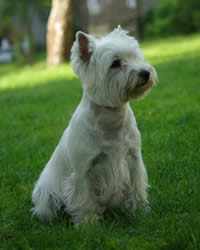West Highland White Terrier Dog Breed Information
 |
| ||||||||||||||||||||||||||||||||||||||||||||||||||||||||||||||||||||||||||||||||
West Highland White Terrier – Just The Facts
| Do you own this Dog breed?Please tell us about it in the form at the bottom of this page. |
General Description
The West Highland White Terrier is a breed that wants to be your “one and only” terrier in the home. This jealous pooch is possessive of its toys and more so its owner, but will gladly welcome your visitors with a wagging tail and an excited bark. Its signature fur color is none other than immaculate white.
Origin and History
Records dating back to the 1800s point to Scotland as the birthplace of these terriers. The dogs were particularly bred to hunt vermin (rats, fox, otter, badger, etc.). People used to call them the Poltalloch or the Roseneath Terrier.
As the white-furred fellows distinguished themselves in show rings, they took on their current name “West Highland White Terrier” from the 1920s and onwards. Today, you can simply call this dog breed a “Westie” and dog lovers will know which terrier dog you’re referring to.
West Highland White Terrier Temperament
A tad more robust than your regular lapdog, the Westie is a jolly, willful and playful breed with an endearingly mischievous streak. They are generally aggressive against small animals and other terriers under the same roof.
Take care not to toy with the dog’s possessions. Westies like to keep their own play things and the full attention of their owners to themselves. However, they’re not the clingy type and can entertain themselves while you are out doing something else. Smother them with too much affection, and you will spoil them considerably. These dogs are clever enough to guess how much you love them.
Care, Grooming, Diet & Exercise
Living Environment – Generally, Westies have moderate tolerance to both hot and cold climates, but it’s best to let them sleep indoors. Since this dog breed has chasing and digging instincts, you may want to have your yard securely fenced for obvious reasons. You don’t want to see your pet going after cats and wreaking havoc on your next-door neighbor’s garden.
Grooming – To keep its white coat clean, the Westie needs to shower at least once a month. It could also use 2 to 3 brushings a week and regular trimming, especially in the hind hair areas. Overall, it takes some effort to keep your Westie looking great. With a proper grooming schedule in place, maintaining the pristine look of this dog breed is guaranteed to be much easier.
Diet & Exercise – Small food portioning is essential to this breed’s nutrition. Resist your Westie’s cute begging ploys and limit their feedings to twice a day. While a dry diet is commonly recommended, free access to drinking water throughout the day is a must.
In terms of exercise, West Highland White Terriers have moderate needs which they can meet either indoors, outdoors or both. They do require some physical challenges on a daily basis but they don’t have to be too strenuous. You can simply take your Westie for a short walk outside or engage them in a game of fetch.
Health – There are a number of potential health issues to consider and monitor with this energetic breed. Westies are prone to allergies, liver complications and degenerative brain disease. The top two major concerns are Legg-Perthes (affecting the joints) and globoid cell leukodystrophy (affecting the bones). On the positive side, they are less delicate than other lap dogs and can live up to 14 years.
West Highland White Terrier Trainability
West Highland White Terriers are not easy to train, but they’re not that difficult to handle either. A technique that often works well with the breed is to use food treats to reinforce lessons.
If you resort to harsh methods, you will find that the naughty Westie will taunt you with gusto and will retaliate by snubbing you. The dog has a lot of spunk!
Do you own this dog breed?
Please tell us about your experience with a particular dog breed, and upload a picture if you have one!
Return to AKC List of Dog Breeds ranked by Popularity
Return from West Highland White Terrier back to Alphabetical List of Dogs Breeds page
Return to Dogs and Dog Advice home